Page 82 of 486
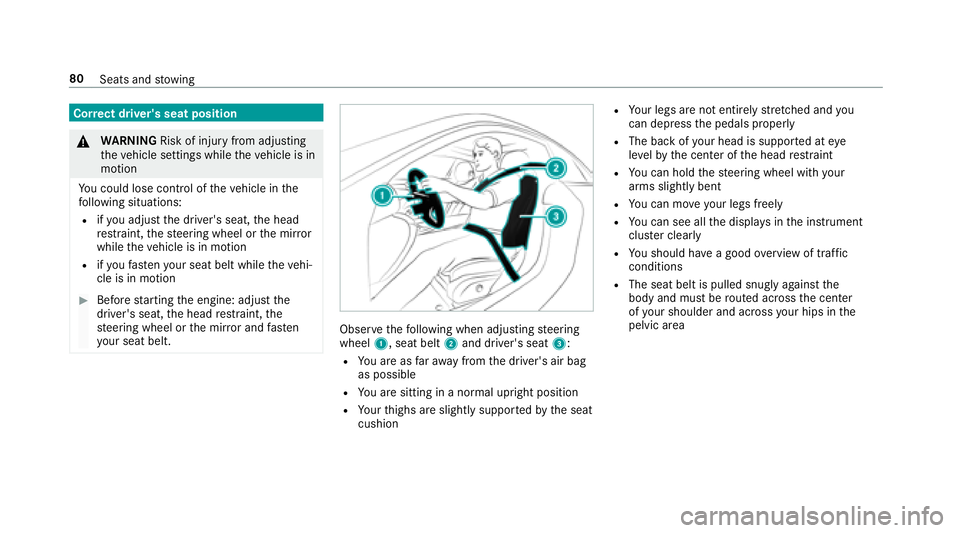
Correct driver's seat position
&
WARNING Risk of injury from adjusting
th eve hicle settings while theve hicle is in
motion
Yo u could lose cont rol of theve hicle in the
fo llowing situations:
Rifyo u adjust the driver's seat, the head
re stra int, thesteering wheel or the mir ror
while theve hicle is in motion
Rifyo ufa sten your seat belt while theve hi‐
cle is in motion
#Before starting the engine: adjust the
driver's seat, the head restra int, the
st eering wheel or the mir ror and fasten
yo ur seat belt.
Obser vethefo llowing when adjusting steering
wheel 1, seat belt 2and driver's seat 3:
RYou are as faraw ay from the driver's air bag
as possible
RYo u are sitting in a no rmal upright position
RYour thighs are slightly supportedby the seat
cushion
RYo ur legs are not entirely stre tched and you
can dep ress the pedals properly
RThe back of your head is support ed ateye
le ve lby the center of the head restra int
RYo u can hold thesteering wheel with your
arms slightly bent
RYo u can mo veyour legs freely
RYo u can see all the displa ysinthe instrument
clus ter clearl y
RYou should ha vea good overview of traf fic
conditions
RThe seat belt is pulled snug lyagainst the
body and must be routed across the center
of your shoulder and across your hips in the
pelvic area
80 Seats and stowing
Page 86 of 486
#Toselect the front passenger seat: press
button 1.
When the indicator lamp lights up, the front
passenger seat is selected.
#Ad just the front passenger seat using the
buttons in the door control panel on the driv‐
er's side.
Ad justing the 4-w aylumbar support
1Toraise
2To sof ten
3To lowe r
4To harden
#Using buttons 1to4, adjust the conto ur
of the backrest individually tosuit your bac k.
Headrestra ints
Ad justing the head restra ints on the front
seats
& WARNING Risk of injury from adjusting
th eve hicle settings while theve hicle is in
motion
Yo u could lose cont rol of theve hicle in the
fo llowing situations:
Rifyo u adjust the driver's seat, the head
re stra int, thesteering wheel or the mir ror
while theve hicle is in motion
Rifyo ufa sten your seat belt while theve hi‐
cle is in motion
#Before starting the engine: adjust the
driver's seat, the head restra int, the
st eering wheel or the mir ror and fasten
yo ur seat belt.
84
Seats and stowing
Page 92 of 486
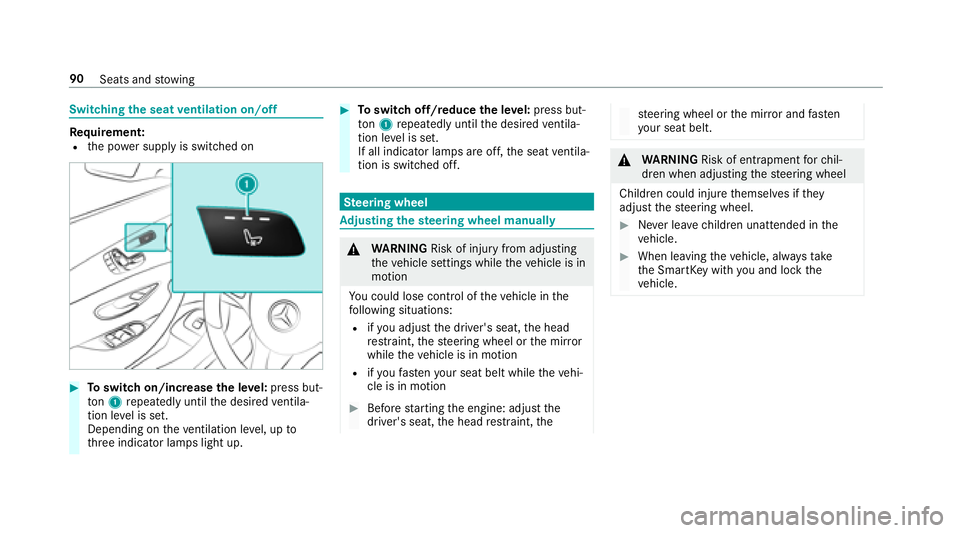
Switchingthe seat ventilation on/off
Re quirement:Rthe po wer supp lyis switched on
#To switch on/increase the le vel:press but‐
to n1 repeatedly until the desired ventila‐
tion le vel is set.
Depending on theve ntilation le vel, up to
th re e indicator lamps light up.
#To switch off/reduce the le vel:press but‐
to n1 repeatedly until the desired ventila‐
tion le vel is set.
If all indicator lamps are off, the seat ventila‐
tion is switched off.
Ste ering wheel
Adjusting the steering wheel manually
&
WARNING Risk of injury from adjusting
th eve hicle settings while theve hicle is in
motion
Yo u could lose cont rol of theve hicle in the
fo llowing situations:
Rifyo u adjust the driver's seat, the head
re stra int, thesteering wheel or the mir ror
while theve hicle is in motion
Rifyo ufa sten your seat belt while theve hi‐
cle is in motion
#Before starting the engine: adjust the
driver's seat, the head restra int, the
steering wheel or the mir ror and fasten
yo ur seat belt.
&
WARNING Risk of entrapment forch il‐
dren when adjusting thesteering wheel
Children could injure themselves if they
adjust thesteering wheel.
#Ne ver lea vechildren unatte nded inthe
ve hicle.
#When leaving theve hicle, alw aysta ke
th e SmartK eywith you and lock the
ve hicle.
90
Seats and stowing
Page 93 of 486
#Tounlock thest eering column: push
re lease le ver1 down comple tely.
#Ad just height 2and di stance tosteering
wheel 3.
#Tolock thest eering column: pushrelease
le ve r1 up as far as it will go.
#Check and make sure that thesteering col‐
umn is loc kedby moving thesteering wheel.
Ad justing the steering wheel electrically
The steering wheel can be adjus ted when the
ignition is switched off.
1Ad justs the dis tance tothesteering wheel
2Ad justs the height
#Sa ve the settings with the memory function
(→page 92).
Switching thest eering wheel heater on/off
1Swit ches on
2Switches off
3Indicator lamp
Seats and stowing 91
Page 94 of 486
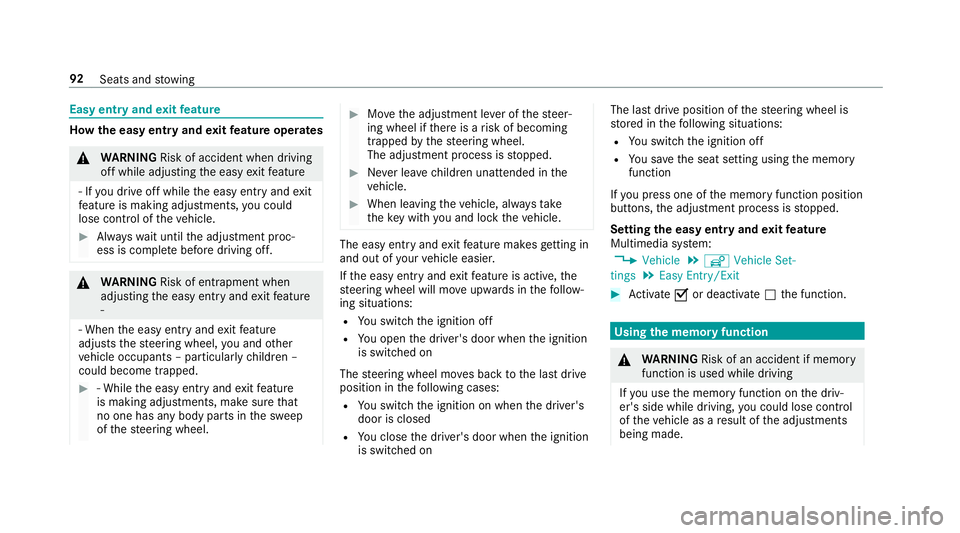
Easy entry andexitfeature
How the easy entry and exitfeature operates
&
WARNING Risk of accident when driving
off while adjusting the easy exitfeature
‑ If youdriv e off while the easy ent ryand exit
fe ature is making adjustments, you could
lose cont rol of theve hicle.
#Alw ayswa it until the adjustment proc‐
ess is comple tebefore driving off.
&
WARNING Risk of entrapment when
adjusting the easy ent ryand exitfeature
‑
‑ When the easy ent ryand exitfeature
adjusts thesteering wheel, you and other
ve hicle occupants – particular lych ildren –
could become trapped.
#‑ While the easy ent ryand exitfeature
is making adjustments, make sure that
no one has any body parts in the sweep
of thesteering wheel.
#Mo vethe adjustment le ver of thesteer‐
ing wheel if there is a risk of becoming
trapped bythesteering wheel.
The adjustment process is stopped.
#Ne ver lea vechildren unatte nded inthe
ve hicle.
#When leaving theve hicle, alw aysta ke
th eke ywit hyo u and lock theve hicle.
The easy entry and exitfeature makes getting in
and out of your vehicle easier.
If th e easy ent ryand exitfeature is active, the
st eering wheel will mo veupwards in thefo llow‐
ing situations:
RYo uswit chthe ignition off
RYo u open the driver's door when the ignition
is switched on
The steering wheel mo ves back tothe last drive
position in thefo llowing cases:
RYo u switch th e ignition on when the driver's
door is closed
RYo u close the driver's door when the ignition
is switched on The last drive position of
thesteering wheel is
st ored in thefo llowing situations:
RYo u switch the ignition off
RYo u sa vethe seat setting using the memory
function
If yo u press one of the memory function position
buttons, the adjustment process is stopped.
Setting the easy entry and exitfeature
Multimedia sy stem:
,�9�H�K�L�F�O�H.î �9�H�K�L�F�O�H �6�H�W��
�W�L�Q�J�V.�(�D�V�\ �(�Q�W�U�\���(�[�L�W
#Ac tivate Oor deacti vate ª the function.
Using the memory function
&
WARNING Risk of an accident if memory
function is used while driving
If yo u use the memory function on the driv‐
er's side while driving, you could lose cont rol
of theve hicle as a result of the adjustments
being made.
92 Seats and stowing
Page 95 of 486
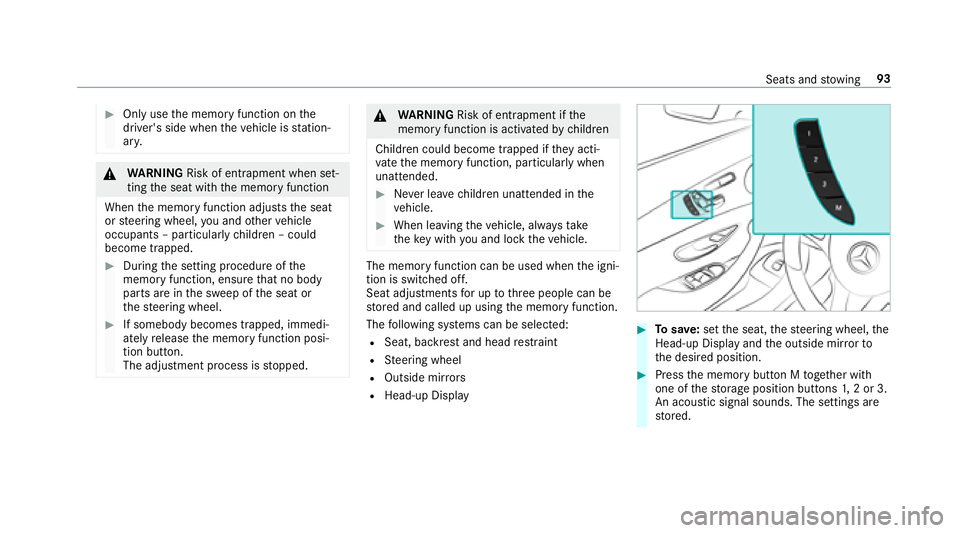
#Only usethe memory function on the
driver's side when theve hicle is station‐
ar y.
&
WARNING Risk of entrapment when set‐
ting the seat with the memory function
When the memory function adjusts the seat
or steering wheel, you and other vehicle
occupants – particularly children – could
become trapped.
#During the setting procedure of the
memory function, ensure that no body
parts are in the sweep of the seat or
th esteering wheel.
#If somebody becomes trapped, immedi‐
ately release the memory function posi‐
tion button.
The adjustment process is stopped.
&
WARNING Risk of entrapment if the
memory function is activated bychildren
Children could become trapped if they acti‐
va te the memory function, particularly when
unattended.
#Ne ver lea vechildren unatte nded inthe
ve hicle.
#When leaving theve hicle, alw aysta ke
th eke ywit hyo u and lock theve hicle.
The memory function can be used when the igni‐
tion is switched off.
Seat adjustments for up tothre e people can be
st ored and called up using the memory function.
The following sy stems can be selected:
RSeat, backrest and head restra int
RSt eering wheel
ROutside mir rors
RHead-up Display
#To save :set the seat, thesteering wheel, the
Head-up Display and the outside mir rorto
th e desired position.
#Press the memory button M toge ther with
one of thestorage position buttons 1,2 or 3.
An acou stic signal sounds. The settings are
st ored.
Seats and stowing 93
Page 112 of 486

Switching onthe high beam manually
#Ve hicles with Adaptive Highbeam Assis t:
Tu rn the light switch totheL position.
RPress the combination switch be yond the
pressure point in the direction of
ar ro w 1.
When the high beam is activated, the indicator
lamp for low beam is deactivated and replaced
by the indicator lamp forth e high beam.
#To switch off the high beam: movethe
combination switch back toits starting posi‐
tion.
#To indicate briefl y:press the combination
switch briefly up tothe pressure point in the
direction of ar row2or4.
The cor responding turn signal light flashes
th re e times.
#To indicate for a duration: pressthe combi‐
nation switch be yond the pressure point in
th e direction of ar row2or4.
Ac tivating/deactivating the hazard warning
light
#Press button 1.
Cornering light
Cornering light function
Cornering light impr ovesth e illumination of the
ro ad ove r a wide angle in the turning direction,
enabling better visibility in tight bends, forex am‐
ple. It can only be activated whenthe low beam
is switched on.
The function is active:
RAt speeds below 25 mph (40 km/h) when
th e turn signal light is switched on or the
st eering wheel is turned.
11 0
Light and visibility
Page 113 of 486
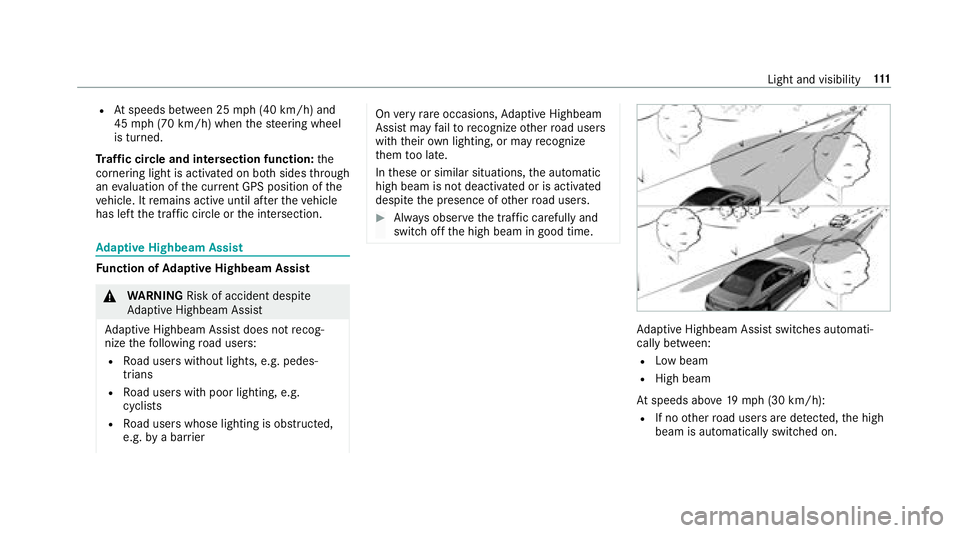
RAtspeeds between 25 mph(4 0 km/h) and
45 mph(7 0 km/h) when thesteering wheel
is turned.
Tr af fic circle and intersection function: the
cornering light is acti vated on bo thsides thro ugh
an eva luation of the cur rent GPS position of the
ve hicle. It remains active until af terth eve hicle
has left the tra ffic circle or the intersection.
Ad aptive Highbeam Assist
Function of Adaptive Highbeam Assist
&
WARNING Risk of accident despite
Ad aptive Highbeam Assist
Ad aptive Highbeam Assist does not recog‐
nize thefo llowing road users:
RRo ad users without lights, e.g. pedes‐
trians
RRo ad users with poor lighting, e.g.
cyclists
RRo ad users whose lighting is obstructed,
e.g. bya bar rier
On very rare occasions, Adaptive Highbeam
Assist may failto recognize other road users
with their own lighting, or may recognize
th em too late.
In these or similar situations, the automatic
high beam is not deactivated or is activated
despite the presence of other road users.
#Alw ays obser vethe tra ffic carefully and
switch off the high beam in good time.
Ad aptive Highbeam Assist switch es automati‐
cally between:
RLow beam
RHigh beam
At speeds abo ve19 mp h (30 km/h):
RIf no other road users are de tected, the high
beam is automatically switched on.
Light and visibility 111